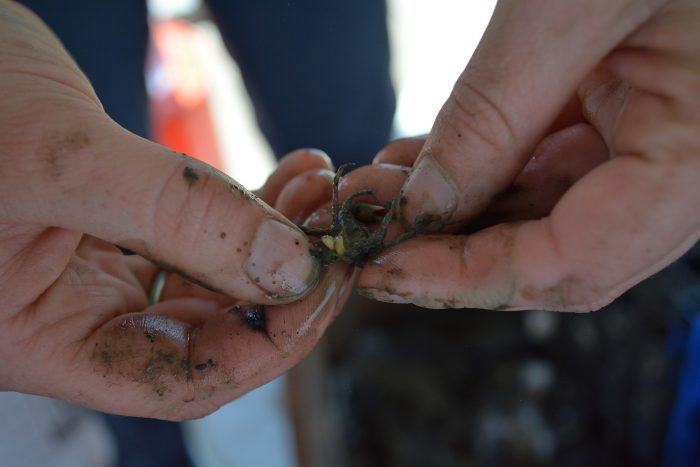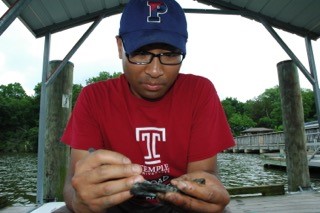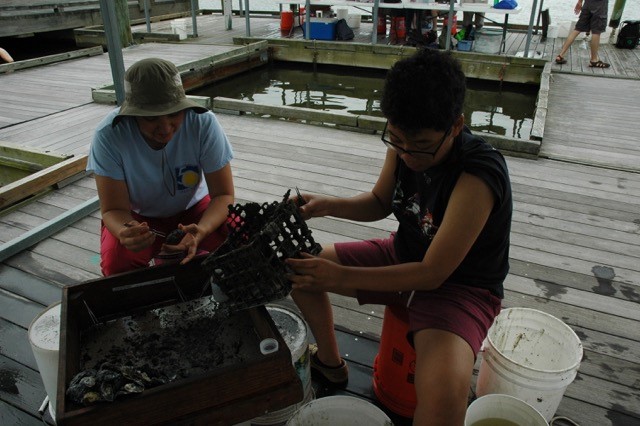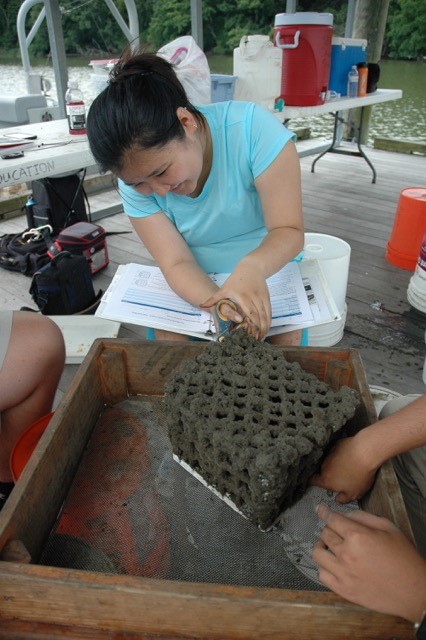Citizen Scientists help tackle creepy threat to native crabs
Nothing says summer on the Chesapeake Bay like crabs. The Environmental Research Center is looking for volunteers to do some serious crabbing–but you’ll probably want to forgo the drawn butter and Old Bay.

This tiny mud crab shows signs of infestation by the parasite Loxothylacus panopaei, (Photo courtesty Alison Cawood)
Bet you didn’t think you could sign up to poke around for “zombie crabs” in the Chesapeake Bay this summer and fall.
Thanks to Smithsonian Environmental Research Center’s Chesapeake Bay Parasite Project, however, you can.
You can also learn about the invasive parasite, Loxothylacus panopaei, colloquially known as “loxo,” that alters the biology of the Bay native mud crab, and what kinds of steps people can take to help improve the health of the Bay.

Research technician Clinton Arriola examines a mud crab for signs of parasitic infestation. (Photo courtesy Alison Cawood)
Loxo is a type of barnacle that becomes enmeshed in the crab’s nervous system says Alison Cawood, citizen science coordinator at SERC, Edgewater, Md.
Cawood, a marine ecologist who earned her doctorate at Scripps Institution of Oceanography, University of California at San Diego, supervises college interns who work at SERC while on summer break (as well as during the school year). In the summer, she’s also in charge of volunteers of all ages and levels of experience who come to search for mud crabs under docks, in piles of debris and other places in and near the water’s edge. Then the mud crabs are checked for loxo, whose effects on the crabs are creepily fascinating.
“A lot of times the crab becomes infected but you can’t see it,” Cawood notes.
When loxo reaches maturity, its fertilized larvae emerge in a sac at the same place on the female crab’s body that she would carry her own young. The crab actually treats the loxo larvae as though they were her own. “From an evolutionary point of view, the crab is dead,” Cawood says (hence the zombie nickname). The parasite has permanently changed the mud crab’s anatomy, physiology and behavior; it can no longer reproduce.
Cawood likens the phenomenon to part of the plot of “Men in Black,” where a giant bug wore a human suit. “This is like a barnacle wearing a crab suit,” she says.

From left, research technician and science lead Monaca Noble and intern Shannon Stafford examining mud crabs. (Photo courtesy Alison Cawood)
No one knows for sure how loxo got to the Chesapeake Bay. The best guess is that sometimes in the 1960s, it arrived with oysters coming north from the Gulf of Mexico, a place where loxo is a native species. Its effect on mud crabs has been significant. “In some places the crab populations have dropped pretty precipitously,” Cawood says. “It definitely has implications for the food web” because birds, fish and other, bigger crabs consume mud crabs.
SERC staff drop milk crate-like boxes stuffed with oyster shells into the Bay in the springtime to lure mud crabs. After a few months, the crab collectors are retrieved and the oyster shells examined by volunteers for mud crabs, which can be minuscule. One that’s thumb-sized is considered quite large; more often than not, they are much smaller. The goal is to find every single crab in the collector.
“It used to be just staff doing the collecting,” Cawood says. “Since it evolved into a citizen-science effort, we doubled the number of crab collectors.” As more crabs in more places are found, and as populations are tracked over time, the more accurate a picture SERC’s Marine Invasion lab scientists like Monaca Noble and Greg Ruiz have of the mud-crab population of the Bay.

Volunteer Rachel Kang empties a crab trap. (Photo courtesy Alison Cawood)
In three-hour shifts, some of the volunteer collectors are families with children (required to be 12 and over) who come back year after year to help; others are retirees who love the Bay and have time to give. Other volunteers count and measure and sex the crabs in the lab. A couple hundred people a year give their time to advance the project.
“People really care about the environment here,” says Cawood, explaining the increasing interest in taking part in this particular citizen science effort. “This gives them a concrete thing to do and helps them understand [ecology] better. It’s also very social; it’s a nice environment to chat in, in a beautiful place.”
If you’re interested in taking part in the Parasite Project, email Alison Cawood at CawoodA@si.edu. She is in need of volunteers August 11-12 and August 18-19 during morning (9 a.m.–12 p.m.) or afternoon (1 p.m.–4 p.m.) shifts.
Posted: 23 July 2018
- Categories:






